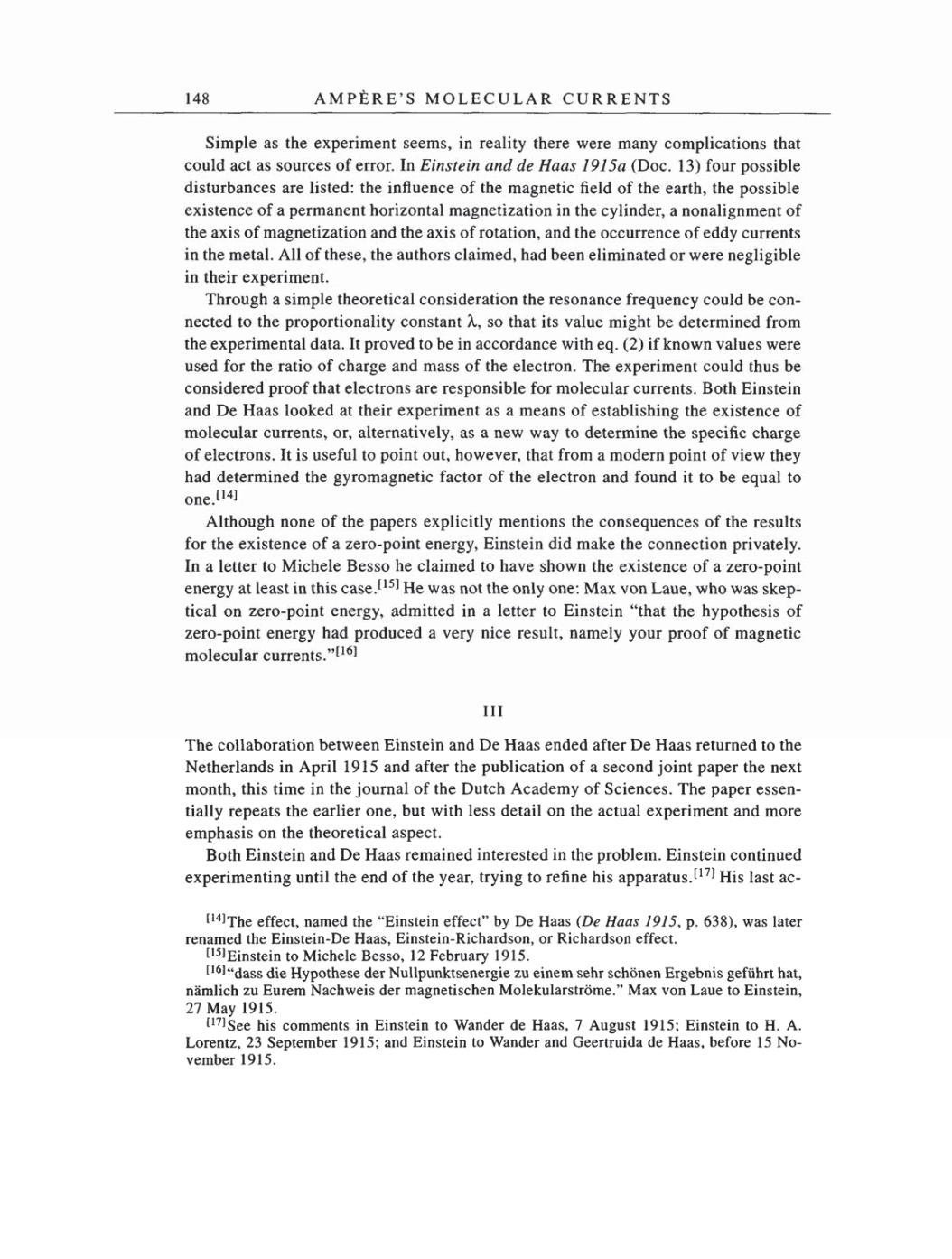148
AMPÈRE'S
MOLECULAR CURRENTS
Simple
as
the
experiment seems,
in
reality
there
were
many complications
that
could
act
as
sources
of
error.
In Einstein and de Haas 1915a
(Doc.
13)
four
possible
disturbances
are
listed: the influence of the
magnetic
field
of the
earth,
the
possible
existence of
a
permanent
horizontal
magnetization
in
the
cylinder,
a
nonalignment
of
the axis of
magnetization
and the axis of
rotation,
and the
occurrence
of
eddy
currents
in the metal. All of
these,
the authors
claimed,
had been eliminated
or were
negligible
in their
experiment.
Through
a
simple
theoretical consideration the
resonance frequency
could
be
con-
nected
to
the
proportionality
constant
X,
so
that its value
might
be
determined from
the
experimental
data. It
proved
to be in accordance
with
eq.
(2)
if
known values
were
used for the ratio of
charge
and
mass
of the electron.
The
experiment
could thus
be
considered
proof
that electrons
are
responsible
for molecular
currents.
Both
Einstein
and De Haas looked
at
their
experiment
as a means
of
establishing
the
existence
of
molecular
currents,
or, alternatively,
as a new
way to
determine the
specific charge
of electrons. It is useful
to
point out, however,
that from
a
modern
point
of
view
they
had
determined
the
gyromagnetic
factor of the electron
and found
it to be
equal
to
one.[14]
Although
none
of the
papers
explicitly
mentions the
consequences
of
the results
for the existence
of
a zero-point energy,
Einstein did
make the connection
privately.
In
a
letter
to
Michele Besso he claimed to have shown the existence of
a
zero-point
energy
at
least
in
this
case.[15]
He
was
not
the
only
one:
Max
von
Laue,
who
was
skep-
tical
on
zero-point energy,
admitted
in
a
letter
to
Einstein "that the
hypothesis
of
zero-point energy
had
produced
a
very
nice
result,
namely your proof
of
magnetic
molecular
currents."[16]
III
The
collaboration
between Einstein and De Haas ended after De Haas returned
to
the
Netherlands
in
April
1915
and after the
publication
of
a
second
joint
paper
the
next
month,
this time
in
the
journal
of the Dutch
Academy
of Sciences. The
paper
essen-
tially repeats
the earlier
one,
but with less detail
on
the actual
experiment
and
more
emphasis
on
the theoretical
aspect.
Both Einstein and
De
Haas remained interested
in
the
problem.
Einstein continued
experimenting
until the end of the
year, trying
to
refine his
apparatus.[17]
His last
ac-
[14]The
effect,
named the "Einstein effect"
by
De
Haas
(De
Haas
1915,
p.
638),
was
later
renamed the Einstein-De
Haas, Einstein-Richardson,
or
Richardson effect.
[15]Einstein
to
Michele
Besso, 12
February
1915.
[16]"dass
die
Hypothese
der
Nullpunktsenergie
zu
einem sehr schönen
Ergebnis geführt
hat,
nämlich
zu
Eurem Nachweis der
magnetischen
Molekularströme." Max
von
Laue
to
Einstein,
27 May 1915.
[17]See
his
comments in
Einstein
to
Wander de
Haas, 7
August 1915;
Einstein
to H. A.
Lorentz,
23
September 1915;
and Einstein
to
Wander and Geertruida
de Haas,
before
15
No-
vember
1915.
